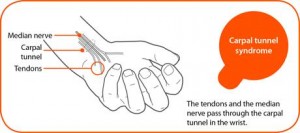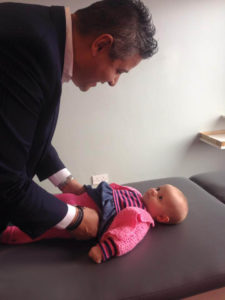Carpal tunnel syndrome (CTS) is the most common of all work-related injuries.
CTS typically occurs in adults, with women 3 times more likely to develop it than men. The dominant hand is usually affected first, and the pain is typically severe.
What Is CTS?
CTS is a problem of the median nerve, which runs from the forearm into the hand. CTS occurs when the median nerve gets compressed in the carpal tunnel—a narrow tunnel at the wrist—made up of bones and soft tissues, such as nerves, tendons, ligaments, and blood vessels. The compression may result in pain, weakness, and/or numbness in the hand and wrist, which radiates up into the forearm.
What Are the Symptoms?
Burning, tingling, itching, and/or numbness in the palm of the hand and thumb, index, and middle fingers are most common. Some people with CTS say that their fingers feel useless and swollen, even though little or no swelling is apparent. In addition, weakened grip strength may make it difficult to form a fist or grasp small objects. Some people develop wasting of the muscles at the base of the thumb. Some are unable to distinguish hot from cold by touch.
Why Does CTS Develop?
You’re working at your desk, trying to ignore the tingling or numbness you’ve had for months in your hand and wrist. Suddenly, a sharp, piercing pain shoots through the wrist and up your arm. Just a passing cramp? More likely you have carpal tunnel syndrome, a painful progressive condition caused by compression of a key nerve in the wrist.
CTS can develop because of an injury to the wrist that causes swelling, over-activity of the pituitary gland, hypothyroidism, diabetes, inflammatory arthritis, mechanical problems in the wrist joint, poor work ergonomics, repeated use of vibrating hand tools, and fluid retention during pregnancy or menopause.
How Is It Diagnosed?
CTS should be diagnosed and treated early. A standard physical examination of the hands, arms, shoulders, and neck can help determine if your symptoms are related to daily activities or to an underlying disorder.
Your chiropractor can use other specific tests to try to produce the symptoms of carpal tunnel syndrome.
What Is the CTS Treatment?
Initial therapy includes:
- Resting the affected hand and wrist
- Avoiding activities that may worsen symptoms
- Immobilizing the wrist in a splint to avoid further damage from twisting or bending
- Applying cool packs to help reduce swelling from inflammations
Chiropractic joint manipulation and mobilization of the wrist and hand, stretching and strengthening exercises, soft-tissue mobilization techniques, and even yoga can be helpful.
If you think you might have Carpel Tunnel Syndrome, talk to Dr. Ben.













